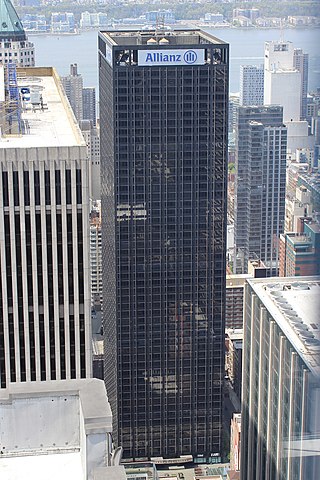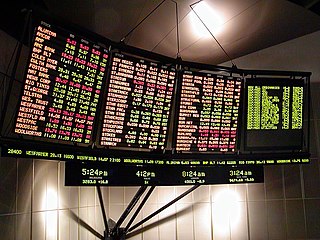Related Research Articles

The Nasdaq Stock Market ( is an American stock exchange based in New York City. It is the most active stock trading venue in the US by volume, and ranked second on the list of stock exchanges by market capitalization of shares traded, behind the New York Stock Exchange. The exchange platform is owned by Nasdaq, Inc., which also owns the Nasdaq Nordic stock market network and several U.S.-based stock and options exchanges.

The Securities Exchange Act of 1934 is a law governing the secondary trading of securities in the United States of America. A landmark of wide-ranging legislation, the Act of '34 and related statutes form the basis of regulation of the financial markets and their participants in the United States. The 1934 Act also established the Securities and Exchange Commission (SEC), the agency primarily responsible for enforcement of United States federal securities law.
An electronic communication network (ECN) is a type of computerized forum or network that facilitates the trading of financial products outside traditional stock exchanges. An ECN is generally an electronic system that widely disseminates orders entered by market makers to third parties and permits the orders to be executed against in whole or in part. The primary products that are traded on ECNs are stocks and currencies. ECNs are generally passive computer-driven networks that internally match limit orders and charge a very small per share transaction fee.

In finance, market data is price and other related data for a financial instrument reported by a trading venue such as a stock exchange. Market data allows traders and investors to know the latest price and see historical trends for instruments such as equities, fixed-income products, derivatives, and currencies.
Regulation National Market System is a 2005 US financial regulation promulgated and described by the Securities and Exchange Commission (SEC) as "a series of initiatives designed to modernize and strengthen the National Market System for equity securities". The Reg NMS is intended to assure that investors receive the best (NBBO) price executions for their orders by encouraging competition in the marketplace. Some contend that the rule has contributed to the rise of high-frequency trading, which is sometimes regarded as controversial.
The Securities Industry Automation Corporation (SIAC) is a subsidiary of the NYSE Euronext. Its purpose is to provide technical services for the exchanges themselves, members and other financial institutions. In this role, SIAC provides the computers and other systems required to run the exchanges. It also owns communication lines and hardware to provide real-time quotes and transaction information to all market participants from the Consolidated Tape/Ticker System (CTS), Consolidated Quotation System (CQS), and Options Price Reporting Authority (OPRA).
A national market system plan is a structured method of transmitting securities transactions in real-time. In the United States, national market systems are governed by section 11A of the Securities Exchange Act of 1934.
The Consolidated Tape Association (CTA) oversees the Securities Information Processor that disseminates real-time trade and quote information in New York Stock Exchange (NYSE) and American Stock Exchange (AMEX) listed securities. It is currently chaired by Emily Kasparov of the Chicago Stock Exchange, the first woman and the youngest chair elected to the position.
In finance, a dark pool is a private forum for trading securities, derivatives, and other financial instruments. Liquidity on these markets is called dark pool liquidity. The bulk of dark pool trades represent large trades by financial institutions that are offered away from public exchanges like the New York Stock Exchange and the NASDAQ, so that such trades remain confidential and outside the purview of the general investing public. The fragmentation of electronic trading platforms has allowed dark pools to be created, and they are normally accessed through crossing networks or directly among market participants via private contractual arrangements. Generally, dark pools are not available to the public, but in some cases, they may be accessed indirectly by retail investors and traders via retail brokers.
The Consolidated Quotation System (CQS) is the electronic service that provides quotation information for stock traded on the American Stock Exchange, New York Stock Exchange, and other regional stock exchanges in the United States and also includes issues traded by FINRA member firms in the third market. Nasdaq processes this data and provides it to its subscribers as the Composite Quotation Service. The initials CQS may be used either for the exchange system or the NASDAQ service.
The Consolidated Tape System (CTS) is the United States electronic service, introduced in April 1976, that provides last sale and trade data for issues admitted to dealings on the American Stock Exchange, New York Stock Exchange, and U.S. regional stock exchanges.
The Options Price Reporting Authority (OPRA) oversees the Securities Information Processor (SIP) that provides last sale information and current options quotations from a committee of participant exchanges. In turn, this committee is designated as the Options Price Reporting Authority.
The National Market System (NMS) is a regulatory mechanism that governs the operations of securities trading in the United States. Its primary focus is ensuring transparency and full disclosure regarding stock price quotations and trade executions. It was initiated in 1975, when, in the Securities Acts Amendments of 1975, Congress directed the Securities and Exchange Commission (SEC) to use its authority to facilitate the establishment of a national market system. The system has been updated periodically, for example with the Regulation NMS in 2005 which took into account technological innovations and other market changes.
High-frequency trading (HFT) is a type of algorithmic trading in finance characterized by high speeds, high turnover rates, and high order-to-trade ratios that leverages high-frequency financial data and electronic trading tools. While there is no single definition of HFT, among its key attributes are highly sophisticated algorithms, co-location, and very short-term investment horizons in trading securities. HFT uses proprietary trading strategies carried out by computers to move in and out of positions in seconds or fractions of a second.
Flash trading, otherwise known as a flash order, is a marketable order sent to a market center that is not quoting the industry's best price or that cannot fill that order in its entirety. The order is then flashed to recipients of the venue's proprietary data feed to see if any of those firms wants to take the other side of the order.

The May 6, 2010, flash crash, also known as the crash of 2:45 or simply the flash crash, was a United States trillion-dollar flash crash which started at 2:32 p.m. EDT and lasted for approximately 36 minutes.

Virtu Financial is an American company that provides financial services, trading products and market making services. Virtu provides product suite including offerings in execution, liquidity sourcing, analytics, broker-neutral, multi-dealer platforms in workflow technology and two-sided quotations and trades in equities, commodities, currencies, options, fixed income, and other securities on over 230 exchanges, markets, and dark pools. Virtu uses proprietary technology to trade large volumes of securities. The company went public on the Nasdaq in 2015.

Securities market participants in the United States include corporations and governments issuing securities, persons and corporations buying and selling a security, the broker-dealers and exchanges which facilitate such trading, banks which safe keep assets, and regulators who monitor the markets' activities. Investors buy and sell through broker-dealers and have their assets retained by either their executing broker-dealer, a custodian bank or a prime broker. These transactions take place in the environment of equity and equity options exchanges, regulated by the U.S. Securities and Exchange Commission (SEC), or derivative exchanges, regulated by the Commodity Futures Trading Commission (CFTC). For transactions involving stocks and bonds, transfer agents assure that the ownership in each transaction is properly assigned to and held on behalf of each investor.
For three hours on August 22, 2013, trading was halted on the Nasdaq Stock Market. Trading on the exchange stopped at 12:14 pm and resumed at 3:25 pm, with 35 minutes left of trading for the day. One week after the trading halt NASDAQ OMX credited the freeze to an overloading of the Securities Information Processor (SIP) caused by reconnection issues with the New York Stock Exchange Arca. The freeze received substantial media coverage and generated discussions on the security of increasingly technologically advanced stock exchanges. The event coined the term "flash freeze" following the earlier "flash crash" on May 6, 2010.
Unlisted Trading Privileges (UTP) oversees the Securities Information Processor for securities listed on Nasdaq and other securities that do not meet the requirements for listing on an exchange.
References
- ↑ Osipovich, Alexander (5 July 2022). "Nasdaq, NYSE Win Court Battle With SEC Over Market Data". Wall Street Journal.
- 1 2 Bartlett, Robert; McCrary, Justin. "How Rigged Are Stock Markets? Evidence from Microsecond Timestamps" (PDF). Retrieved 27 May 2023.
- ↑ "Frequently Asked Questions". Options Price Reporting Authority. Retrieved 27 May 2023.
- ↑ "SEC Adopts Rules to Modernize Key Market Infrastructure Responsible for Collecting, Consolidating, and Disseminating Equity Market Data". U.S. Securities Exchange Commission.
- ↑ "Final Rule: Regulation NMS" (PDF). U.S. Securities Exchange Commission.
- ↑ "Reg NMS Shades of Grey". Bloomberg Professional Services. Bloomberg. 26 August 2014.
- ↑ "The SEC's Market Data Infrastructure Rule: What's next?". RBC Capital Markets.
- ↑ "Nasdaq Lose SEC Market Data Infrastructure Rule Challenge". Bloomberg Law.
- ↑ "SEC directs exchanges to file new market data governance plan". Pensions and Investments.
- ↑ "Current and Historical Market Data Revenue Information Now Available from the Securities Information Processors (SIPs)" (Press release). PR Newswire.
- ↑ "Statement on Proposed Rule on Market Data Infrastructure".
- ↑ "Processor Disclosure Form 2023" (PDF). Retrieved 27 May 2023.
- ↑ "Processor Disclosure Form January 2023" (PDF). Retrieved 27 May 2023.
- ↑ "Proposed Rule: Market Data Infrastructure, Securities Exchange Act Release No. 88216" (PDF). U.S. Securities Exchange Commission. Retrieved 27 May 2023.
- ↑ "SEC proposes adding more stock price information to market data feeds". Reuters. 14 February 2020.
- ↑ "SEC looks to expand SIP with 'depth of book' data in major overhaul plans". The Trade. Retrieved 27 May 2023.
- ↑ "Flash Friday: Why the Market Data Monopoly Won't Be Nirvana". Trader Magazine. 8 July 2022. Retrieved 27 May 2023.
- ↑ "BATS clarifies statement made on CNBC". CNBC. 4 April 2014.
- ↑ Patterson, Scott (3 April 2014). "BATS Forced to Correct Statements by President O'Brien on How Its Exchanges Work". Wall Street Journal.
- ↑ Osipovich, Alexander (22 October 2019). "Tiny 'Odd Lot' Trades Reach Record Share of U.S. Stock Market". Wall Street Journal.
- ↑ "Market data plans revive proposals to move odd lots into SIPs". WatersTechnology. 22 April 2022.
- ↑ Schwenk-Nebbe, Sander (March 17, 2022). "The Participant Timestamp: Get The Most Out Of TAQ Data". SSRN. doi:10.2139/ssrn.3744743. S2CID 234581292. SSRN 3744743.
- ↑ "Equities data". Databento. Retrieved 23 November 2023.
- ↑ Theissen, Erik (June 2001). "A test of the accuracy of the Lee/Ready trade classification algorithm". Journal of International Financial Markets, Institutions and Money. 11 (2): 147–165. doi:10.1016/S1042-4431(00)00048-2.